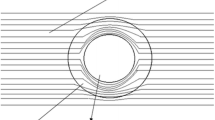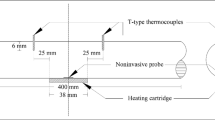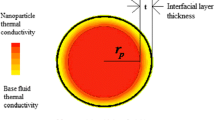Abstract
The nano particles have demonstrated great potential to improve the heat transfer characteristics of heat transfer fluids. Possible parameters responsible for this increase were studied. The heat transfer profile in the nanolayer region was combined with other parameters such as volume fraction, particle radius thermal conductivity of the fluid, particle and nanolayer, to formulate a thermal conductivity model. Results predicting the thermal conductivity of nanofluids using the model were compared with experimental results as well as studies by other researchers. The comparison of the results obtained for the CuO/water and TiO2/water nanofluids studied shows that the correlation proposed is in closest proximity in predicting the experimental results for the thermal conductivity of a nanofluid. Also, a parametric study was performed to understand how a number of factors affect the thermal conductivity of nanofluids using the developed correlation.
Similar content being viewed by others
References
KEBLINSKI P, EASTMAN J A, CAHILL D. Nanofluids for thermal transport [J]. Materials Today, 2005, 8(23): 36–44.
PRASHER R S, BAHATTACHARYA P, PHELAN P E. Thermal conductivity of nanoscale colloidal solutions (nanofluids) [J]. Phys Rev Lett, 2005, 94: 025901-1–025901-4.
EVANS W, FISH J, KEBLINSKI P. Role of Brownian motion hydrodynamics on nanofluid thermal conductivity [J]. Appl Phy Lett, 2006, 88: 093116-1–093116-3.
MAXWELL J C. A treatise on electricity and magnetism [M]. Second Ed., Vol. 1. Oxford, UK, Clarendon Press, 435.
YU W, CHOI S U S. The role of interfacial layers in the enhanced thermal conductivity of nanofluids: A renovated Maxwell model [J]. Journal of Nanoparticle Research, 2003, 5: 167–171.
HAMILTON R L, CROSSER O K. Thermal conductivity of heterogeneous two component systems [J]. I & EC Fundamentals, 1962, 1: 182–191.
YU W, CHOI S U S. The role of interfacial layers in the enhanced thermal conductivity of nanofluids: A renovated Hamilton-Crosser model [J]. Journal of Nanoparticle Research, 2004, 6: 355–361.
WASP E J, KENNEJ J P, GANDHI R L. Solid-liquid flow, slurry pipeline transportation: Slurry pipeline design [M]. 1st Ed. Trans Tech Publications, 1977: 9–32.
KEBLINSKI P, PHILLPOT S R, CHOI S U S, EASTMAN J A. Mechanism of heat flow in suspension of nano-sized particles (nanofluids) [J]. International Journal of Heat and Mass Transfer, 2002, 45: 855–863.
WANG Bu-xuan, ZHOU Le-ping, PENG Xiao-feng. A fractal model for predicting the effective thermal conductivity of liquid with suspension of nanoparticles [J]. International Journal of Heat and Mass Transfer, 2003, 46(14): 2665–2672.
KUMAR H D, PATEL H E, RAJEEV KUMAR V R, SUNDARARAJAN T, PRADEEP T, DAS S K. Model for heat conduction in nanofluids [J]. The American Physical Society, 2004, 93: 144301-1–144301-4.
JEFFREY D J. Conduction through a random suspension of spheres [J]. Proceedings of the Royal Society of London, Series A: Mathematical and Physical Sciences, 1973, 335(1602): 355–367
JANG S P, CHOI S U S. Role of Brownian motion in the enhanced thermal conductivity of nanofluids [J]. Applied Physics letter, 2004, 84: 4316–4318.
LI Shin-yuan. Critical interfacial characteristics for the effective conductivities of isotropic composites containing spherical inclusions [J]. Journal of Applied physics, 1995, 77(10): 5215–5219.
LU S Y, SONG J L. Effective thermal conductivity of composites with spherical inclusion: effect of coating and detachment [J]. Journal of Applied Physics, 1996, 77: 609–618.
TIMOFEEVA E V, GAVRILOV A N, MC-CLOSKEY J M, TOLMACHEV Y V. Thermal conductivity and particle aggregation in alumina nanofluids: Experiment and theory [J]. The American Physical Society, 2007, 76: 061203-1–061203-16.
LEONG K C, YANG C, MURSHED S M S. A new model for thermal conductivity of nanofluids — the effect of interfacial layer [J]. Journal of Nanoparticle Research, 2006, 8: 245–254.
LEE S, CHOI S U S, LI S, EASTMAN J A. Measuring Thermal Conductivity of fluids containing oxide nanoparticles [J]. ASME J Heat Transfer, 1999, 121: 280–289.
FENG Y, YU B, XU P, ZOU M. The effective thermal conductivity of nanofluids based on the nanolayer and the aggregation of nanoparticles [J]. Journal of Physics D: Applied Physics, 2007, 40: 3164–3171.
KIM S H, CHOI S R, KIM D. Thermal conductivity of metal-oxide nanofluids: Particle size dependence and effect of laser irradiation [J]. Journal of Heat Transfer, 2007, 129: 298–307.
XIE Que-zhong. Model for effective thermal conductivity of nanofluids [J]. Physics letters, A, 2003, 307: 313–317.
EASTMAN J A, CHOI S U S, LI S, YU W, THOMPSON L J. Anomalously increased effective thermal conductivities of ethylene glycol based nanofluids containing copper nanoparticles [J]. Applied Physics Letters, 2001, 78(6): 718–720.
HONG T, YANG H, CHOI C J. Study of the enhanced thermal conductivity of Fe nanofluids [J]. Journal of Applied Physics, 2005, 97: 064311.
Author information
Authors and Affiliations
Corresponding author
Rights and permissions
About this article
Cite this article
Azari, A. Thermal conductivity modeling of water containing metal oxide nanoparticles. J. Cent. South Univ. 22, 1141–1145 (2015). https://doi.org/10.1007/s11771-015-2626-3
Received:
Accepted:
Published:
Issue Date:
DOI: https://doi.org/10.1007/s11771-015-2626-3




